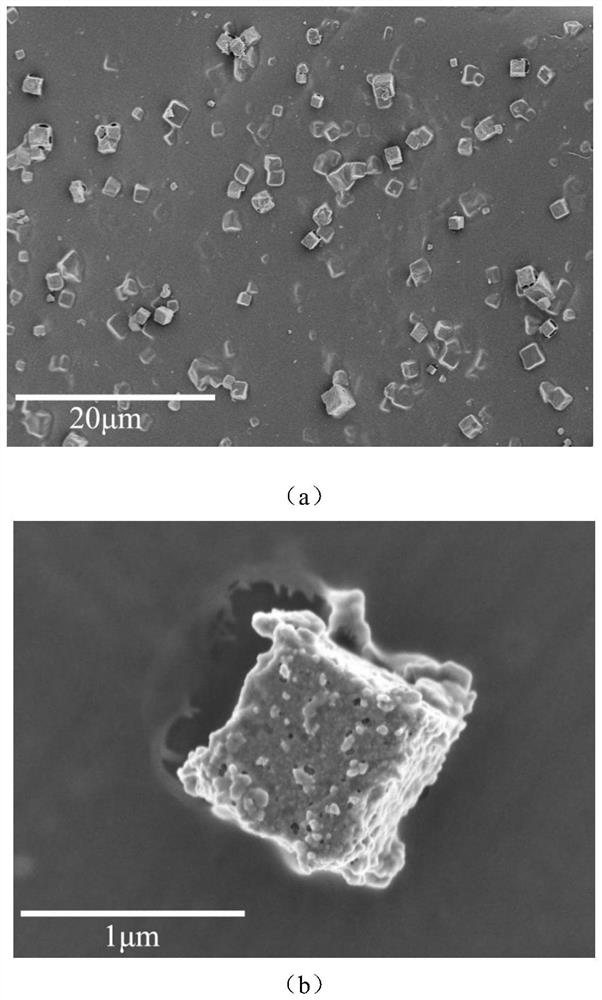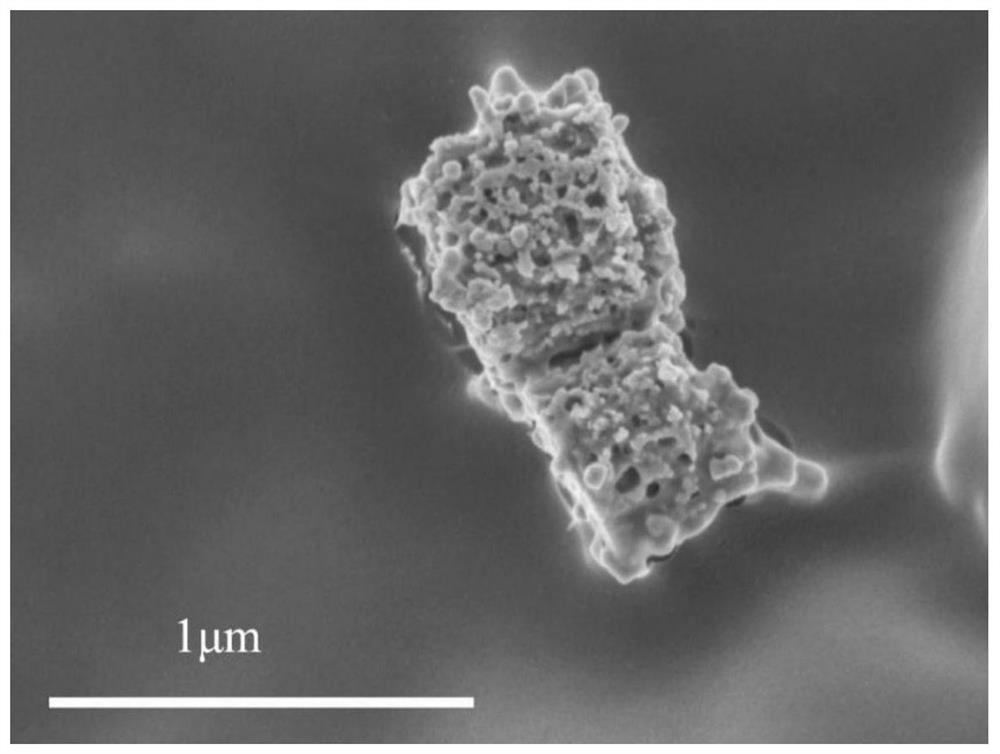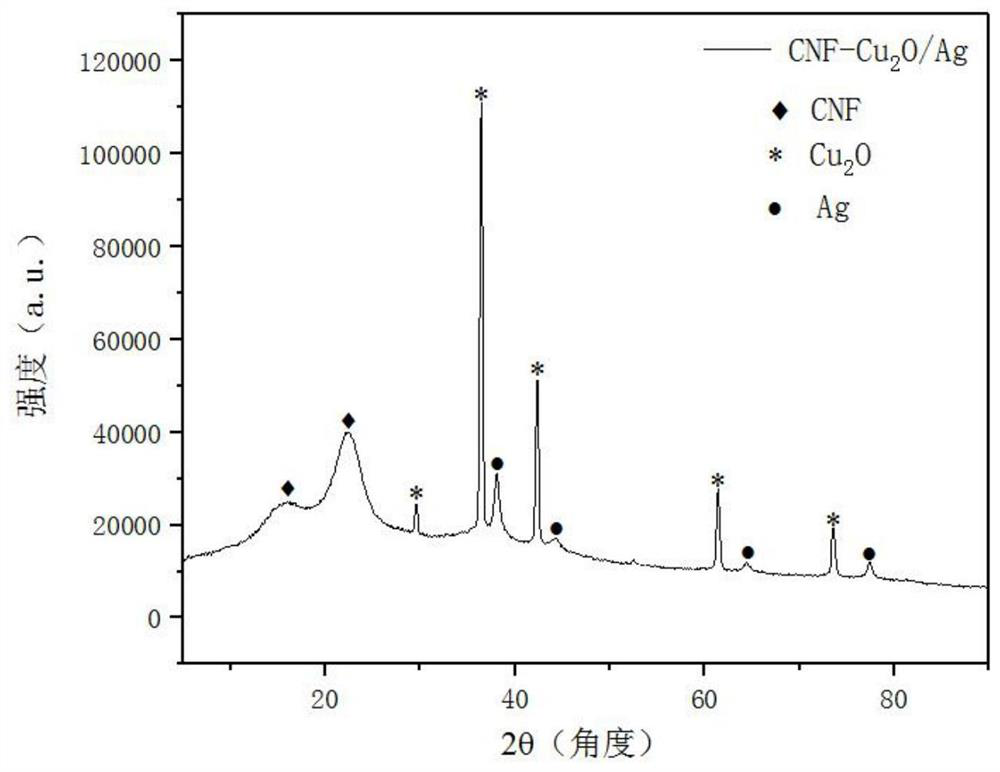TEMPO-pretreated nanocellulose-cuprous oxide/silver micro-nano structure composite material as well as preparation method and application thereof
A technology of nano-cellulose and cuprous oxide, applied in chemical instruments and methods, analytical materials, material excitation analysis, etc., can solve the problem of difficulty in meeting safe and green production requirements, reduced ability to adsorb small molecule dyes, and small specific surface area etc. to achieve excellent surface scattering enhancement performance, short response time, and high sensitivity
- Summary
- Abstract
- Description
- Claims
- Application Information
AI Technical Summary
Problems solved by technology
Method used
Image
Examples
Embodiment 1
[0042] A preparation method of TEMPO pretreated nanocellulose-cuprous oxide / silver micro-nano structure composite material, comprising the steps of:
[0043] 1. Dissolve 6.92g of sodium carbonate in 20mL of deionized water, 0.4g of sodium citrate in 20mL of deionized water, and 0.692g of copper sulfate pentahydrate in 20mL of deionized water. Add the uniform mixed solution of the sodium carbonate solution and the sodium citrate solution to the copper sulfate pentahydrate solution, and move the above mixed solution to a 100mL volumetric flask, dilute the solution in the container to the mark, and obtain Benedict's reagent;
[0044] 2. With 1g of bleached wood pulp (cellulose content is 98%, breaking length is 7.6km, viscosity is 17mPa.s), 0.016g 2,2,6,6-tetramethylpiperidine oxide (TEMPO), 0.1 g of sodium bromide was mixed and stirred at 1000 rpm for 5 min to make it evenly mixed. Then add 5mmol / L sodium hypochlorite solution and mix evenly, use 0.02mol / L sodium hydroxide solu...
Embodiment 2
[0049] 1. Dissolve 6.92g of sodium carbonate in 20mL of deionized water, 0.4g of sodium citrate in 20mL of deionized water, and 0.692g of copper sulfate pentahydrate in 20mL of deionized water. Add the uniform mixed solution of the sodium carbonate solution and the sodium citrate solution to the copper sulfate pentahydrate solution, and move the above mixed solution to a 100mL volumetric flask, dilute the solution in the container to the mark, and obtain Benedict's reagent;
[0050] 2. With 1g of bleached wood pulp (cellulose content is 98%, breaking length is 7.6km, viscosity is 17mPa.s), 0.016g 2,2,6,6-tetramethylpiperidine oxide (TEMPO), 0.1 g of sodium bromide was mixed, and stirred for 5 min at 1000 rpm to make it evenly mixed. Then add 5mmol / L sodium hypochlorite and mix evenly, and use 0.02mol / L sodium hydroxide solution to control the pH value of the solution to keep it at 9.8-10.2. When the pH value of the mixed solution does not change within a short period of time,...
Embodiment 3
[0055] 1. Dissolve 6.92g of sodium carbonate in 20mL of deionized water, 0.4g of sodium citrate in 20mL of deionized water, and 0.692g of copper sulfate pentahydrate in 20mL of deionized water. Add the uniform mixed solution of the sodium carbonate solution and the sodium citrate solution to the copper sulfate pentahydrate solution, and move the above mixed solution to a 100mL volumetric flask, dilute the solution in the container to the mark, and obtain Benedict's reagent;
[0056] 2. With 1g of bleached wood pulp (pure cellulose content is 98%, breaking length is 7.6km, viscosity is 17mPa.s), 0.016g TEMPO (2,2,6,6-tetramethyl piperidine oxide) , 0.1 g of sodium bromide, and stirred for 5 min at 1000 rpm to make them evenly mixed. Then add 5mmol / L sodium hypochlorite and mix evenly, and use 0.02mol / L sodium hydroxide solution to control the pH value of the solution to keep it at 9.8-10.2. When the pH value of the mixed solution does not change within a short period of time, ...
PUM
| Property | Measurement | Unit |
|---|---|---|
| Breaking length | aaaaa | aaaaa |
| Viscosity | aaaaa | aaaaa |
| Width | aaaaa | aaaaa |
Abstract
Description
Claims
Application Information
 Login to View More
Login to View More - R&D
- Intellectual Property
- Life Sciences
- Materials
- Tech Scout
- Unparalleled Data Quality
- Higher Quality Content
- 60% Fewer Hallucinations
Browse by: Latest US Patents, China's latest patents, Technical Efficacy Thesaurus, Application Domain, Technology Topic, Popular Technical Reports.
© 2025 PatSnap. All rights reserved.Legal|Privacy policy|Modern Slavery Act Transparency Statement|Sitemap|About US| Contact US: help@patsnap.com



